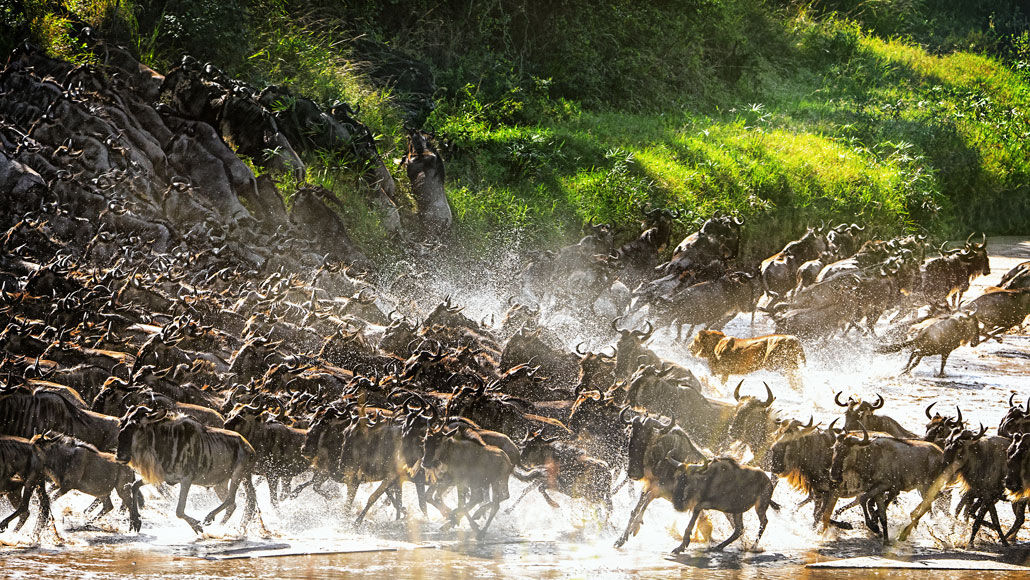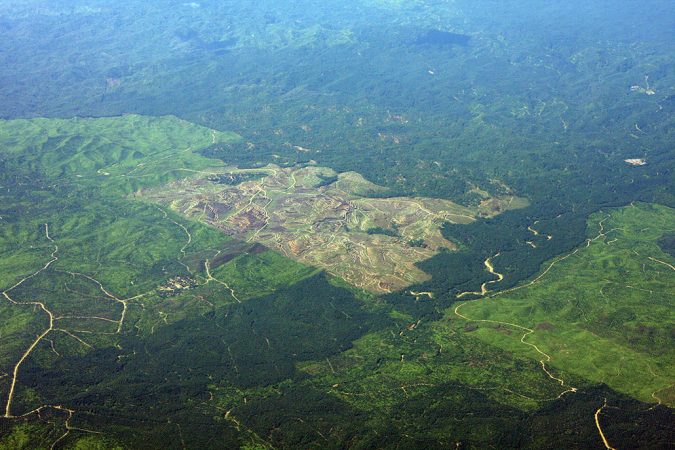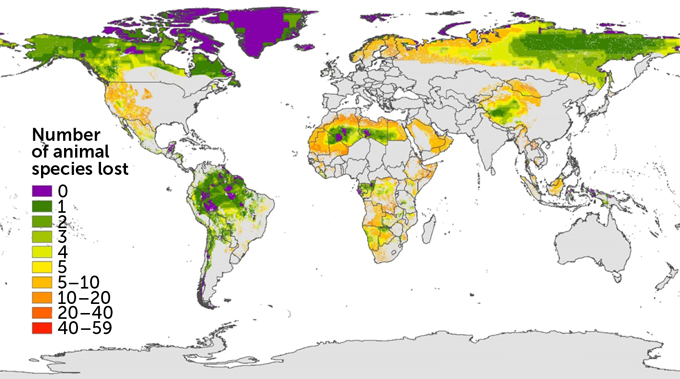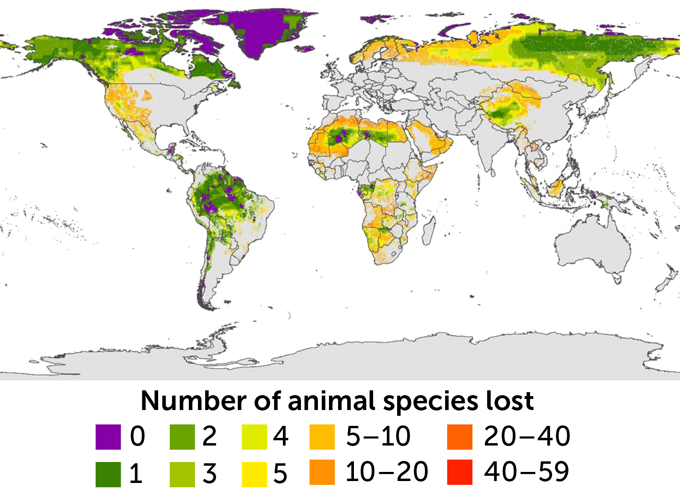Only 3 percent of Earth’s land is unchanged by people
Land clearing, pollution and other human activities have affected species around the globe

The Serengeti is one of the few places on Earth that still houses all the animal species it did hundreds of years ago. Top predators, like lions, help keep herds of grazing wildebeests (pictured) in check. That ensures the overall ecosystem stays balanced.
Vicki Jauron, Babylon and Beyond Photography/Moment/Getty Images Plus
The African Serengeti looks much like it did hundreds of years ago.
Huge herds of wildebeests, over one million strong, still roam the savanna. Lions, hyenas and other top predators stalk the herds. This keeps their prey from eating too much vegetation. Diverse trees and grasses support scores of other species, from vivid green-orange Fischer’s lovebirds to dung beetles. In turn, such species carry seeds or pollen across the plains, aiding the spread of plants.
Overall, the Serengeti is a prime example of what biologists call an ecologically intact ecosystem. A bustling tangle of relationships work together. This sustains a rich diversity of life. People are there, but represent only a small part of the whole. And they don’t disrupt the rest of the system.
Such places are vanishingly rare. Ecosystems on nearly all the Earth’s land — a staggering 97 percent — no longer are intact. That’s according to a sweeping new survey of Earth’s land-based ecosystems. Over the last 500 years, many have lost habitat or species. In others, populations of key animals have shrunk. Just 3 percent of the surveyed lands are unchanged, researchers reported April 15 in Frontiers in Forests and Global Change.

Even the few remaining intact ecosystems may be at risk. Only about 11 percent of them are within protected areas, the researchers found. Much of the intact land overlaps areas that now are or were historically managed by Indigenous people. Those people often have played a vital role in maintaining healthy ecosystems, the researchers say. One way these habitats could be conserved, many scientists think, would be to make sure that Indigenous communities retain legal rights to manage these lands.
Much of the last pristine habitat exists in the far North. Think Canada’s boreal forests or Greenland’s icy tundra. Neither are bursting with biodiversity. But chunks of rainforests in the Amazon, Congo and Indonesia still host species-rich ecosystems.
“These are the best of the best. The last places on Earth that haven’t lost a single species that we know of,” says Oscar Venter. He works at the University of Northern British Columbia in Prince George, Canada. He is a conservation scientist who did not take part in the new study. It’s crucial to identify these ecological gems, he says. Some may be under threat of development. Among those is the Amazon rainforest. Mapping where these largely unaltered sites are is the first step toward protecting them.
Conservation scientists have long tried to map humanity’s touch. Previous estimates used data on where people live. Others used images from satellites. Such images can reveal physical changes, such as roads and damaged forests. They even can show indirect effects such as light pollution. In those studies, 20 to 40 percent of the globe appear little changed by people.
But many human effects may not be obvious, notes Andrew Plumptre. He is a conservation biologist at the University of Cambridge in England. “Hunting, the impacts of invasive species, climate change,” Plumptre notes. “These can harm ecosystems. But they can’t be easily sensed via satellite.” Imagine the Serengeti with fewer lions or hyenas — or none at all. It would look the same from space. But it would be missing key species that help the whole ecosystem run.
Plumptre wanted another way to measure the influence of people. He and his colleagues looked for ecosystems that haven’t changed as human populations have grown and spread. They defined an intact ecosystem as one that has all the same species today and at the same levels as it did in 1500. (The International Union for the Conservation of Nature starts from that year when counting species extinctions. Even long before that, though, people changed nature, such as by wiping out big mammals.)
Where the wild things (still) are
The team combined several types of existing data. They looked for places where habitats seem undisturbed by people. And they used three different measures of where species have been lost. The data covered about 7,500 animal species. Put together, the data showed undisturbed regions that had kept all their critters.
Some wide-ranging species need large swaths of land. So the researchers first looked for areas larger than 10,000 square kilometers (3,900 square miles). (That’s roughly the size of Puerto Rico.) Only 2.9 percent of undisturbed land areas that big still hold all the species they did 500 years ago. Then they looked at smaller areas, of 1,000 square kilometers (390 square miles). That bumped the percentage up just a bit, to 3.4.
Degraded ecosystems
Human activity has effects that reach nearly the whole globe. Many areas have lost species, as color-coded on this map. Based on a survey of about 7,500 animal species, purple areas show the 3 percent of land where no known species have been lost since the year 1500.
Lost species in the wilderness


There’s more to an ecosystem than just who’s in it, though. Lower numbers of key species can also throw a system out of whack. The researchers tallied up the population densities of 15 types of large mammals. These included gorillas, bears and lions. Together, the chosen species span much of the globe. Why large mammals? They play important roles in ecosystems, Plumptre explains. The best historical data exist for these. They also are often the first to be affected by human neighbors.
Some of those mammals had declined in places that were otherwise intact. Accounting for dropped the ecologically intact total down to 2.8 percent of all land.
Overall, the tally of intact ecosystems “was much lower than we were expecting,” Plumptre says. “Going in, I’d guessed that it would be 8 to 10 percent. It just shows how huge an impact we’ve had.”
Understanding the challenge
Jedediah Brodie is a conservation ecologist at the University of Montana in Missoula. He and Venter both wonder if the study authors were too strict in how they defined “intact.”
“Many ecosystems around the world have lost one or two species but are still vibrant, diverse communities,” Brodie says. In such places, a drop in a few species may not spell disaster for the whole ecosystem. Other species may swoop in to fill those roles.
Still, the study is a valuable first look. It shows us “where the world looks like it did 500 years ago and gives us something to aim for,” Plumptre says. It also identifies areas that could be restored. Adding back up to five lost species could restore 20 percent of land to its former glory, the researchers calculate.
Reintroducing lost species has worked well in some places. In Yellowstone National Park, bringing back wolves has put the ecosystem back into balance. Such schemes may not work everywhere. But deciding how to protect nature is a growing, global challenge. Plumptre hopes policy makers will take note. It’s possible to “not just protect the land that’s there, but also think about restoring it to what it could be.”







